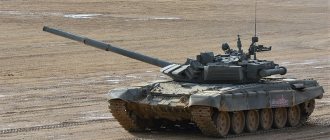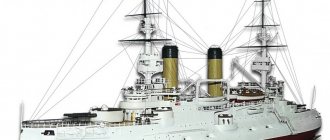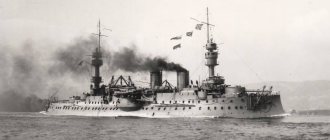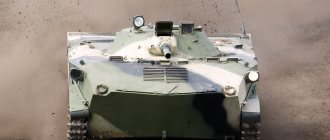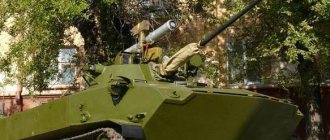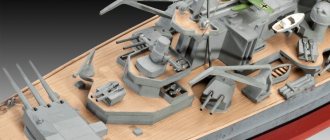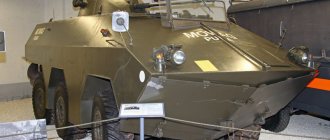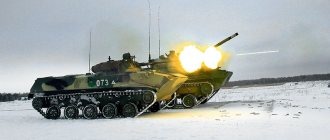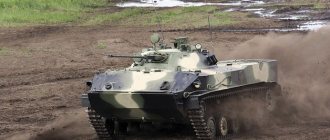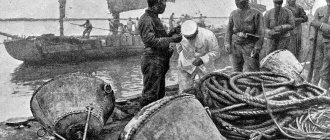Cultural hello
As you know, during the American Civil War a new class of ships appeared. We are talking about the so-called monitors, all of whose weapons were placed in rotating turrets.
However, the lightweight design of the turret by engineer Erickson did not allow the installation of heavy guns in it for a serious naval battle. The fact is that the monitor towers were very imperfect. During the trip they simply lay on the deck. And during the battle, the tower was raised on a central axis and rotated, supported by special wheels.
And so, the English designer and shipbuilder Cooper Coles proposed his own version of the tower, which rested not on a central pin, but on several dozen rollers rolling along a circular steel groove - a shoulder strap. In such a tower it was possible to place the heaviest guns in service at that time.
Turret battleship “Royal Sovereign”, England, 1864
In 1866, four turrets designed by Coles with 267 mm muzzle-loading guns were installed on the hull of the wooden battleship Royal Sovereign, cut off along the lower deck. The result was a very low, relatively narrow, well-armed ship, protected by 140mm armor.
Turret battleship “Monarch”
The British carried out a risky experiment, firing at one of the Royal Sovereign towers from a 229 mm cannon from a distance of about 200 meters. The gun in the turret did not receive any damage, and the turret itself continued to rotate normally. The Royal Sovereign's problem was different - due to its low side, it could not be in a stormy sea without the risk of being flooded by waves.
Turret battleship “Captain”
Coles managed to convince the admirals of the promise of a tower battleship, and in the same 1866, he received consent to build two ships at once, equipped with artillery systems of a new type. The first of them was built at the state-owned shipyard and was named “Monarch”, the second, laid down a year later, was built at the private Cammell Laird shipyard and received, rather unusual for a ship, the name “Captain” (“Captain”).
Both ships had a lot in common. Their main armament - four huge muzzle-loading 305-mm Armstrong guns - was housed in two cylindrical turrets mounted in the middle part of the hull. The guns were not able to fire at the stern and bow. This was hampered by high superstructures and masts. The firing sectors were “cut” only into the sides, like the old battery battleships.
Turret battleship “Royal Sovereign”, England, 1864
The guns had an extremely low rate of fire - about one shot every three minutes. This is understandable. The process of reloading turret guns was a very complex process, especially considering the enormous weight of the guns, shells and charges.
After the salvo, the turret was placed in a neutral position - with the gun embrasures forward. The platform with both guns rolled back completely inside the turret, turned its barrels in the direction opposite to the embrasures, after which the gun barrels went down. Propelling charges consisting of several tens of kilograms of black powder, sewn into special silk bags called caps, were supplied to their muzzles by lifts.
Turret battleship “Monarch”, England, 1869
It was necessary to push two caps with gunpowder into each barrel to the very end (to the breech). This was done using long poles with thickening at the ends (rammers). Then, from the shell magazine, a two-hundred-kilogram cast-iron shell—a cylindrical bomb filled with explosives—was fed to the muzzle of each barrel.
Helical grooves were applied to its sides, with which the projectile was screwed into the rifling of the gun. After the shells were sent into the breech of the guns, the platform with the cannons again turned with its barrels towards the embrasures and rolled forward, the cannon muzzles again protruded out of the turret. Then the guns had to be aimed at the target and fired.
At the same time, the work of the tower servants in battle turned into a living hell, because let’s not forget that the towers were turned by muscular force, and multi-ton cannons were aimed vertically with the help of clumsy gates, which also had to be turned manually. Suffice it to say that turning the tower alone required the effort of forty sailors! And after the shot, the gun servants had to recover from the terrible roar and gunpowder smoke.
Turret battleship “Captain”, England, 1870
So, the Monarch was launched in 1868, and the Captain a year later. Both ships had almost the same architecture and sailing rig of three-masted frigates, but there were also serious differences.
The construction of the Monarch was closely monitored by military specialists and Admiralty officials, including England's chief shipbuilding engineer E. Reid. Therefore, the battleship was built in strict accordance with the design, was not overweight, had a high hull, on the upper deck of which the towers were located. Moreover, during a storm, the towers were additionally covered with special lifting parts of the sides.
"Captain" had the same towers, but located one deck lower than those of the "Monarch", in the so-called "wells" between the superstructures. The towers rose only two meters above the water. It was believed that heavy towers should be located as low as possible so that the ship does not lose stability. True, this also made the ship unseaworthy. After all, during a strong storm, water could flood the towers. The situation was aggravated by the presence of three heavy masts, each of which also had two supports.
To work with the sails, a narrow hanging deck was laid over the towers. Add to this the strong structural overload of the ship, allowed due to the lack of control over the activities of the private shipyard by the Admiralty. But experts warned that with a list of 21 degrees, the Captain's turrets would begin to go under water, leaks would appear and the ship would capsize in a matter of minutes.
However, the flawedly designed battleship was nevertheless accepted by the Royal Navy in the summer of 1870. And then what should have happened happened.
In early September, "Captain" went out to shoot in the English Channel. This was his first trip. Designer Coles was on board, and decided to personally check the operation of the towers. In 1870, on September 6, the battleship was caught in a storm. The captain's commander ordered the sails to be lowered, but the sailors were unable to do so: it was simply impossible to work on the narrow overhang deck with strong pitching.
At night the storm intensified, the battleship began to list heavily. Water began to penetrate into the hull through the shoulder straps and embrasures of the towers. Soon, the Captain capsized and sank. Cooper Coles himself died along with a significant part of the team.
Battleship Hercules, 1869.
As a result of the trial, all responsibility for the death of the newest battleship on its first voyage was divided equally between the builder Cammell Laird and the designer, the late Coles.
Admiralty officials, who imposed on him a whole series of “changes and improvements” to the project, which led to a sad ending, in particular, the too low location of the towers and heavy tripod masts, came out unscathed. The deceased does not care what undeserved sins are pinned on him.
The death of the Captain dealt a serious blow to the reputation of turret battleships. It seemed that oblivion awaited them. But the impeccable service of the Monarch, which at one time became the fastest battleship in the British fleet, saved the situation.
The criticism of opponents of the sailing equipment of warships was also taken into account. Only now did conservatives from the Admiralty decide to completely abandon sailing weapons. As a result, the warship project was born, which became the standard for all navies of the world for the next few decades. Its creator was the chief designer of English ships, Edward Reed.
"Devastation" General view and longitudinal section
The new battleship had a low side and two turrets located in front and behind the central superstructure. Their guns had huge sectors of fire that were not blocked by anything. One small mast served only to place observers in the “crow’s nest” and provide flag signals. She did not carry any sails.
However, even outdated steam engines allowed the ship to reach a speed of 13.4 knots. The underwater bow of the ship's hull was made in the form of a huge three-meter ram.
Bow turret of the battleship "Devanstation"
The towers had heavy armor, a thick armored citadel also covered the turret compartments and everything that was between them - vehicles and boilers. Interestingly, the armor on the ship was two-layered. Between the armor plates, which were 15 and 18 centimeters thick, there was a thick teak gasket.
Only the ends of the ship and its superstructure, in which the living quarters were located, remained unreserved. Due to the fact that both towers were closely adjacent to the central superstructure, ships built according to this design subsequently received the name citadel battleships.
Guns in the turret
Skeptical of Reed's ideas, the Admiralty nevertheless issued an order for two experimental citadel battleships, limiting their displacement to 9,000 tons. To “fit” into the allotted weight limit, Reed had to make the bow and stern of his creations lower by one deck. To save the towers from being flooded in a storm, the front and rear bulkheads that enclosed the citadel had to be made high and strong enough so that the waves would break against them before reaching the towers.
Muzzle-loading gun
Both innovative ships were laid down even before the death of the Captain, in 1869, and during construction their designs were repeatedly adjusted. After Reed was fired as chief shipbuilder, his successor, William White, insisted on increasing the volume of the central superstructure to improve crew living conditions.
Two "floating experiments" entered service in 1872 and were named "Devastation" ("Destruction") and "Thanderer" ("Thunderbreaker"). "Devastation" at the time of its entry into service was criticized by the press - the memory of the death of the equally low-sided "Captain" was too fresh. But at the same time, the fact was ignored that the cause of the death of the ill-fated battleship were masts with sails, which the Devastation had no trace of.
As one British designer of battleships later wrote, “Certainly, no ship has ever left base under the cover of such a cloud of pessimism and bad forecasts as the Devastation, and at the same time, not a single ship of such an innovative design has lived up to its hopes.” creators as fully as he."
The Devastation carried 1,722 tons of coal, giving the ship a cruising range of 4,578 nautical miles—an unheard-of figure at the time. The ship was described as “a miracle of fortification technology, built on a floating coal mine.”
She was the first iron ship built at the Royal Portsmouth Naval Dockyard. She was built in 1871 and delivered to the Navy on April 19, 1873, after trials completed in January of that year.
Battleship Dreadnought
The third battleship of the series, Dreadnought (Nonstrashimy), was built according to an improved design, with a “normal” side height at the ends, so that it turned out to be smooth-decked.
Another country that decided to build a citadel tower battleship was Russia. Back in 1869, on Galerny Island, at a private shipyard in St. Petersburg, they began to build the unspared battleship “Cruiser”. In 1872 it was launched and renamed “Peter the Great”.
Battleship "Peter the Great"
In terms of the perfection of its layout, it was even ahead of the British Devastation, which was laid down at the same time, and most of all resembled the later Dreadnought with its high, seaworthy sides. True, the equipment of the new Russian ship was delayed for another eight years, and the construction of other powerful battleships of this type in Russia did not continue.
At the same time, it should be noted that the English Dreadnought also took a very long time to complete and entered the British fleet four years later than Peter the Great.
Peter the Great
For a whole decade, Peter the Great remained the only Russian first-line warship. But by the end of the 20th century it was already hopelessly outdated. After 1917, the battleship was renamed "Republican" and served for several more years as an artillery training ship in the Baltic Fleet. The ship was finally decommissioned and melted down only in 1959 - almost 90 years after its construction!
Speaking about the battleship "Peter the Great", it should be noted that this ship played an important role in the history of world shipbuilding. When the tower battleship Captain sank in 1870, the English admirals thought about parting with the towers. But their opinion changed not only because the battleship Monarch showed itself very worthy.
Peter the Great 1881, England
The main factor was the information that reached the British that a new generation warship was being created in Russia, armed with high-power cannons in rotating turrets, in no way inferior to the Devastation-class battleships that had just been laid down.
